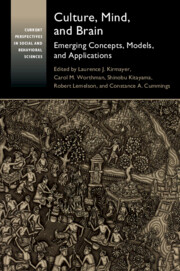Book contents
- Culture, Mind, and Brain
- Current Perspectives in Social and Behavioral Sciences
- Culture, Mind, and Brain
- Copyright page
- Dedication
- Epigraph
- Contents
- Figures
- Tables
- Contributors
- Preface
- Abbreviations
- 1 Introduction
- Part I Dynamics of Culture, Mind, and Brain
- Section 1 The Co-emergence of Culture, Mind, and Brain
- Section 2 The Situated Brain
- 5 Culture in Mind – An Enactivist Account
- 6 The Brain as a Cultural Artifact
- 7 Cultural Priming Effects and the Human Brain
- 8 Culture, Self, and Agency
- Section 3 How Social Coordination and Cooperation are Achieved
- Part II Applications
- Index
- References
6 - The Brain as a Cultural Artifact
Concepts, Actions, and Experiences within the Human Affective Niche
from Section 2 - The Situated Brain
Published online by Cambridge University Press: 18 September 2020
- Culture, Mind, and Brain
- Current Perspectives in Social and Behavioral Sciences
- Culture, Mind, and Brain
- Copyright page
- Dedication
- Epigraph
- Contents
- Figures
- Tables
- Contributors
- Preface
- Abbreviations
- 1 Introduction
- Part I Dynamics of Culture, Mind, and Brain
- Section 1 The Co-emergence of Culture, Mind, and Brain
- Section 2 The Situated Brain
- 5 Culture in Mind – An Enactivist Account
- 6 The Brain as a Cultural Artifact
- 7 Cultural Priming Effects and the Human Brain
- 8 Culture, Self, and Agency
- Section 3 How Social Coordination and Cooperation are Achieved
- Part II Applications
- Index
- References
Summary
In this chapter, we discuss the hypothesis people help to regulate each other’s bodies (for better or for worse), and this is a main mechanism through which culture wires a human brain. Cultural transmission prepares the developing brain and body to meet recurrent demands within a particular cultural context, thereby supporting the development of an internal model that is sufficiently tuned to specific environments. In this way, a human brain becomes wired to run a model of the world that will control the body in an efficient, predictive manner. Our approach provides an empirically inspired account of how a human brain becomes a cultural artifact.
Keywords
- Type
- Chapter
- Information
- Culture, Mind, and BrainEmerging Concepts, Models, and Applications, pp. 188 - 222Publisher: Cambridge University PressPrint publication year: 2020



